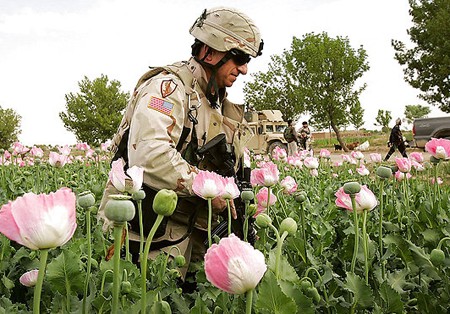- Old US Army Campsite
- A Tale Of Aloha
- Shaking Off The Blahs
- Run Duty Run
- Music Is A Wonderful Thing But
- The Good The Bad And The Pudding
- An Example Of Kindness
- A Few More Things To Do On Oahu
- Tom Pains Ghost Visits Duty
- And Another Child Is Born
- How Barracks Ought To Be
- Weight Control Program Toughens Up Duty
- Our Loyalties Must Transcend Our Race
- Shammer Infects Poetics Lab With Apathy
- Dreaming About The Infantry
- Ku Ana O Laka I Ka Mauna
- A Love Story
- One Stressful Morning
- Going Before The Board
Shammer Infects
Poetics Lab With Apathy
~ Clyde Collins ~
SSgt. Rocky Ride, NCOIC of the Poetics Lab, and his lone troop, PFC Donald Duty, inspiration specialist, were sitting at their lab desks. They were wondering what kind of poetry to contrive for a problem patient on Ward Pluto who did not want to get well.
Duty was about to suggest they stick the patient's data sheet into the Blues Analysis Computer when Pvt. 2 Abalene Asinine, a sham specialist from the Wouldn't-you-like-to-know Division, moseyed into the lab.
After a newly introduced conversation drifted from one trivial subject to another for 10 to 15 minutes, Asinine sympathetically said, "Oh Donald, you look so depressed. Have you had a hard day?"
What she did not realize, thought Duty, was that the cause of his low-down mood was her presence. He had long since forgotten what it was he was going to suggest to Ride. He could not even remember what the problem was for which he might have had a solution. Duty, without a word, turned away from Asinine, stared at the bulletin board next to his desk and gritted his teeth.
Asinine slowly focused on what the inspiration specialist was looking at on the bulletin board ~ a clipping from a local military publication whose headline read: "Are you a time waster?" She chuckled and answered her own question, "I guess I am." She then turned toward Ride and began another dull tale concerning the rigors of having to work for a living.
Duty sprang from his chair, grabbed an armful of books and said, "Sergeant, may I be dismissed to return these books to the library?"
Ride waved a hand. "Go ahead. We don't seem to be accomplishing much at the moment."
When Duty returned, Asinine was still sitting there moaning and groaning and making oddball jokes. Duty sat down at his desk, pulled a handkerchief out of a drawer and polished the new PFC insignia on his shirt collar. Asinine was going to be a private 2 until the day she died, thought Duty with a vengeance.
After the sham specialist departed, Ride, with a wrinkle of perplexity upon his brow, muttered, "What were we doing before Abalene came in here?"
Duty fruitlessly tried to remember. "Ohhh, I don't know."
Ride accidentally broke a pencil that happened to be in his hands and shrugged, "Oh well. At this point, I don't care."
###

Afghanistan poppy field
###
Report on Afghanistan
By Lisa Daniel
American Forces Press Service
WASHINGTON, May 3, 2011 – Last year’s surge of U.S. and coalition forces into Afghanistan, with the simultaneous growth of Afghan forces, is leading to tangible progress for peace and prosperity in Afghanistan, according to a biannual Defense Department report released last week.
The final component of 30,000 U.S. surge forces reached Afghanistan last fall, complemented by an additional 10,000 coalition forces and more than 1,100 U.S. civilian personnel, allowing for significant improvements in security, governance and the economy of Afghanistan, according to the Report on Progress Toward Security and Stability in Afghanistan and the United States Plan for Sustaining the Afghanistan National Security Forces.
Known as the “1230 Report” for its citation in the 2008 National Defense Authorization Act, the report assesses the situation in Afghanistan from Oct. 1 through March 31.
Among its conclusions:
-- Additional forces have allowed the coalition to expand into 34 districts that now have Afghan local police, compared to just eight districts with local police presence in September.
-- Security has improved in each of International Security Assistance Force’s six regional commands. Afghan forces have improved such that they are in the lead for most operations in the capital of Kabul. As expected, violence has increased in the southern provinces of Helmand and Kandahar, as coalition and Afghan forces took away long-held insurgent safe havens.
-- Surveys show Taliban influence decreasing in key areas across the country, with 75 percent of Afghans believing it would be bad for the country if the extremist group returned to power. That compares to 68 percent who felt that way at the end of the last reporting period in September.
-- Reports suggest increased friction between rank-and-file insurgents in Afghanistan and their leaders in Pakistan. The national government’s Afghan Peace and Reintegration Program has allowed more than 700 former Taliban to reintegrate into Afghan society, and another 2,000 insurgents are in the process of reintegration since the office was created in July.
-- The Afghan national security forces are key to Afghan self-sufficiency, and the forces are growing in numbers and competency. The army has added 21,200 new recruits since the end of September, and the national police have 15,030 new recruits since then. Also, 30,000 members of the security forces have completed literacy training, and about 60,000 others are in literacy training on any given day.
-- The Afghan defense and interior ministries have freed up leadership billets for security forces, encouraged merit-based promotions, and recently opened armor and signals schools.
-- By the end of March, 74 percent of battalion-sized army units were rated “effective with advisors” or “effective with assistance,” compared to 51 percent at the end of September. In the national police, 75 percent of units received that rating.
-- Effectiveness has improved to the point that 95 percent of all Afghan army units and 89 percent of national police are partnered with coalition units.
-- A shortage of coalition trainers and high Afghan attrition remain challenging. Incentive programs are being created to mitigate attrition.
-- Afghanistan is showing improvements in governance and development, with about half of the population living in areas of “emerging” governance, compared to 38 percent at the end of September. The national government’s Afghan Civil Service Institute has graduated 16,000 civil servants since Oct. 1 and has placed 3,000 college graduates in its internship program.
-- Allegations of voter fraud from the September national elections continue to reverberate, but have not deterred local elections, such as one in March in which 75 percent of registered voters in Helmand’s Marja district voted.
-- A lack of infrastructure remains a challenge, but improvements are happening with public projects such as a new railway link from the northern city of Mazar-e-Sharif to Uzbekistan, a new power transmission line into the Afghan capital of Kabul, a runway extension at Herat Airport, and extensive road renovations.
-- Significant political challenges remain in Afghanistan, and corruption and criminal networks are a problem, but economic development, including from foreign investors, has potential for promising gains. The demand for energy far exceeds its current supply, and the U.S. Agency for International Development oversees several projects for improvement.
-- The national government continues to develop the mining industry, which has grown by 30 percent in two years since the U.S. Geological Survey estimated Afghanistan’s untapped mineral resources to be valued at as much as $3 trillion.
The report also found significant progress in the distribution of telecommunications service, health care, and education.
“The 2010 surge of ISAF forces and civilian personnel, and the ongoing surge of [Afghan forces], has allowed ISAF to get the inputs right in Afghanistan for the first time,” the report says.
The next report is due at the end of October.
###
Howdy Soldier!

Hell